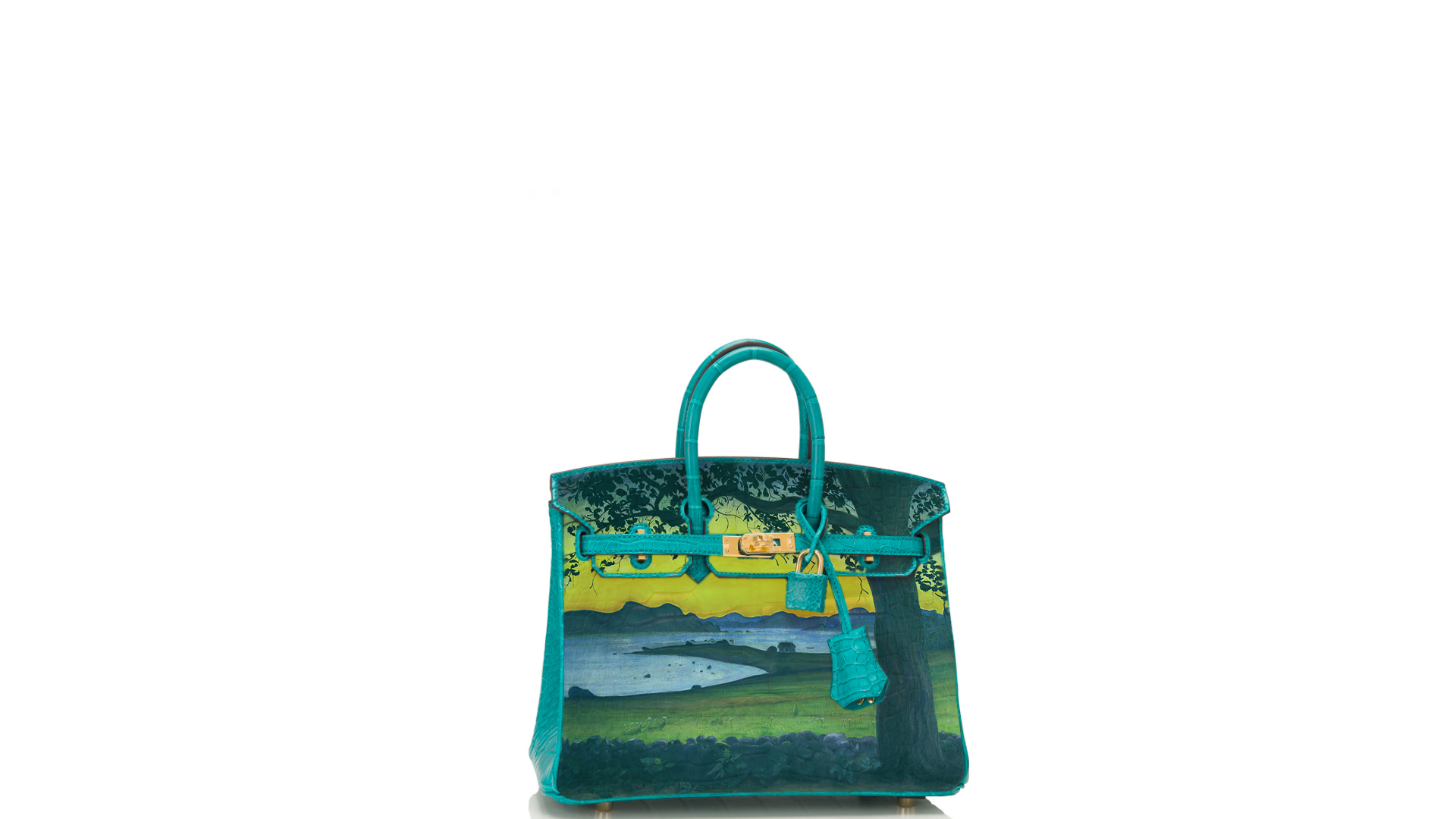Hermes Blue Paon Matte Alligator Birkin 25cm GHW Harald Sohlberg
Hermes Blue Paon Matte Alligator Birkin 25cm Gold Hardware by ARTBURO Personalization, Harald Sohlberg "From Værvågen, The Fisherman's Cottage", 1921.
This Birkin has tonal stitching, a front toggle closure, a clochette with lock and two keys, and double rolled handles.
The interior is lined with Blue Paon chevre and has one zip pocket with an Hermes engraved zipper pull and an open pocket on the opposite side.
Collection: X
Origin: France
Accompanied by: Hermes box, Hermes dustbag, clochette, lock, two keys, clochette dustbag, carebook, carebook dustbag, rainhat, CITES, and felt
Measurements: 10" width x 7.5" height x 4.75" depth; 2.75" handle drop.
Harald Sohlberg "From Værvågen, The Fisherman's Cottage", 1921
From Værvågen, The Fisherman’s Cottage, ranks among Harald Sohlberg’s most evocative landscapes, and marks the culmination on a grand scale of one of the painter’s most important themes. Immersed in the Romantic tradition, in the present work Sohlberg powerfully conveys his quasi-religious reaction before the sublime scale of nature, which he experienced with 'such intensity, that one trembles and feels so extremely tiny and imperfect and ignorant, that one remains standing, humble as if during the most moving devotions'.
Coming three years after Edvard Munch's final public exhibition in Oslo, Sohlberg made his breakthrough at the Oslo state exhibition in March 1894 with the seminal landscape Night Glow (fig. 1). Bought by fellow artist Eilif Peterssen, the painting was then acquired by the Oslo National Gallery. Spurred on by support from collector and patron of the arts Olaf Schou among others, Sohlberg travelled in 1900 to the Rondane mountains. His legendary experiences there inspired Winter Night in the Mountains: an icon of Norwegian art, the 1914 version is a highlight of the Oslo National Gallery (fig. 2).
Particularly relevant in the gestation of the present work is Fisherman's Cottage, painted in Venice in 1907 and exhibited in that year's Biennale, and now in the collection of the Art Institute of Chicago(fig. 3). Its sale to an American collector seven years later followed Sohlberg's inclusion in the successful American-Scandinavian Society exhibition touring New York, Buffalo, Toledo, Chicago and Boston, which attracted nearly 200,000 visitors. Noting the ordinariness of the subject, Sohlberg nevertheless reflected on the way his state of mind transformed the scene to produce an arresting and transcendent image: 'in the highly receptive mood that happened to possess me at the time, all moved me much, and awakened intense interest.'
Spending the summer of 1918 at Skjeggestad, Sohlberg returned to the Vestfold region, south-west of the Oslofjord, in 1920. There at Værvågen he was drawn to the form of the small cottage on the shore surrounded on three sides by water. Revisiting the scene in 1921, Sohlberg situates the cottage to the right of centre, the only man-made structure in this pure landscape, and subdues the palette of the land and water relative to the glowing sunset, achieved with the artist's customary thin glazes. By this stage, warm orange had become dominant over Sohlberg's earlier blue palette, and his output had reduced dramatically to just one large canvas a year.
Throughout his career Sohlberg repeatedly denied any claims that he was under the influence of Edvard Munch, six years his senior. Nevertheless, his vivid palette and sinuous lines in general, and particularly the spreading branches of the tree first seen in Evening, Akershus, and subsequently developed in the present work, bear more than passing resemblance to the ash tree in Munch's mural History, from the Aula of Oslo University. Perhaps recognising the homage, of Sohlberg's work Munch particularly admired Evening, Akershus, along with Winter Night in the Mountains.
Sohlberg's own form of Synthetism, inspired by continental Symbolism and the stemningsmaleri or 'mood-painting' which characterised Nordic art at the close of the 20th Century, had less of a psychological component than Munch's. Sohlberg's precise, accomplished draughtsmanship - magnificently deployed in the present work to emphasise the dislocation between the near tree and distant, cosmic openness - clearly differs from the expressive brushstroke of his compatriot. An exhibition exploring the artists' relationship was held in New York in 1995, titled Munch/Sohlberg: Landscapes of the Mind.

